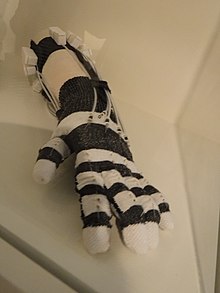Haptic perception
Haptic perception (Greek: haptόs "palpable", haptikόs "suitable for touch") means literally the ability "to grasp something". Perception in this case is achieved through the active exploration of surfaces and objects by a moving subject, as opposed to passive contact by a static subject during tactile perception.[1]
History
The term haptik was coined by the German Psychologist Max Dessoir in 1892, when suggesting a name for academic research into the sense of touch in the style of that in "acoustics" and "optics".[2][3]
Gibson (1966)[4] defined the haptic system as "[t]he sensibility of the individual to the world adjacent to his body by use of his body". Gibson and others further emphasized what Weber had realized in 1851: the close interdependence of haptic perception and body movement, and that haptic perception is active exploration.[citation needed]
The concept of haptic perception is related to the concept of extended physiological proprioception, according to which when a tool such as a stick is used, perceptual experience is transparently transferred to the end of the tool.[5]
Haptic perception relies on the forces experienced during touch.[6] This research allows the creation of "virtual", illusory haptic shapes with different perceived qualities,[7] which has clear application in haptic technology.[8]
Exploratory procedures
People can rapidly and accurately identify three-dimensional objects by touch.[9] They do so through the use of exploratory procedures, such as moving the fingers over the outer surface of the object or holding the entire object in the hand.[10]
The following exploratory procedures have been identified so far:
- Lateral motion
- Pressure
- Enclosure
- Contour following
Thus gathered object or subject properties are size, weight, contour, surface and material characteristics, consistency and temperature. Along with the development of tactile sensors, some work has also been dedicated to developing exploratory behavior in robots.[11]
Perceptual deadband
Perceptual deadband is a region which captures perceptual limitations of human perception.[12] The Weber fraction[1] and the level crossings constant[13] are employed to define the perceptual deadband for haptic force stimulus. The deadband has an important application in designing perceptually adaptive sampling mechanisms for haptic data compression,[14] which is required for transmitting haptic data over a communication network.
There are many factors which affect the possible shapes of the perceptual deadband, for example:
- Rate of change of force stimulus:[15] The Weber fraction or level crossings constant decrease for a faster change in the force stimulus.
- Temporal resolution:[16] It is defined as the minimum time spacing required in perceiving two consecutive force samples.
- Directional sensitivity:[17] The study claims that the Weber fraction is a function of only the force magnitude, not the direction.
- Task being performed: discriminative or comparative [12] A user is more sensitive while doing a comparative task than a discriminative task. It is because one has to perceive changes only along one direction under the comparative task. All this signifies that the perceptual deadband is a function of the task to be carried out.
Impairments of haptic sensitivity
Haptic sensitivity can be impaired by a multitude of diseases and disorders, predominantly relating to

Loss of the sense of touch is a catastrophic deficit that can impair walking and other skilled actions such as holding objects or using tools.
Haptic therapy
Immersive environments can recreate the feeling of haptic interaction.[18] Exoskeletal gloves such as the Exo-Skin Soft Haptic exoskeletal interface, developed at Drexel University, can be programmed to take a patient through a program of physical therapy exercises to retrain muscles and senses.[19]
See also
References
- ^ a b Weber, E. H. (1851). Die Lehre vom Tastsinne und Gemeingefühle auf Versuche gegründet. Friedrich Vieweg und Sohn.
- ^ Dessoir, M. (1892). Über den Hautsinn. Arch. f. Anat. u. Physiol., Physiol. Abt., 175–339.
- ^ Grunwald, M. & John, M. (2008). German pioneers of research into human haptic perception. In M. Grunwald (Ed.), Human Haptic Perception (pp. 15–39). Basel, Boston, Berlin: Birkhäuser.
- ISBN 0-313-23961-4.
- ^ "PROPRIOCEPTION | 7 Senses Foundation". Retrieved 2019-02-14.
- ^ "Robles-De-La-Torre & Hayward. Force Can Overcome Object Geometry In the perception of Shape Through Active Touch. Nature 412 (6845):445-8 (2001)" (PDF). Archived from the original (PDF) on 2006-10-03. Retrieved 2008-06-02.
- ^ "The Cutting edge of haptics"
- ^ Robles-De-La-Torre G. Principles of Haptic Perception in Virtual Environments. In Grunwald M (Ed.), Human Haptic Perception, Birkhäuser Verlag, 2008. Archived 2011-07-26 at the Wayback Machine
- PMID 4034346.
- S2CID 3157751.
- PMID 31896135.
- ^ OCLC 1002015744.)
{{cite book}}:|last=has generic name (help)CS1 maint: multiple names: authors list (link - S2CID 18524110.
- S2CID 52541254.
- ISBN 978-3-662-44192-3
- S2CID 756663.
- ISBN 978-981-10-6691-7
- PMID 25570174.
- ^ Koerner, M.; Fedorczyk, J.; Cohen, A .; Dion, G. "Design and Implementation of the Exo - Skin Soft Robotic Rehabilitation Exoskeleton" (PDF). Drexel University. Retrieved 10 May 2017.
Further reading
- Grunwald, M. (Ed., 2008). Human haptic perception - Basics and Applications. Basel/Boston/Berlin: Birkhaeuser. ISBN 978-3-7643-7611-6
- Lederman, S. J.; Klatzky, R. L. (1990). "Haptic classification of common objects: Knowledge-driven exploration". Cognitive Psychology. 22 (4): 421–459. S2CID 6619282.
- Montagu, A. (1971). Touching: The human significance of the skin. Oxford, England: Columbia U. Press.
